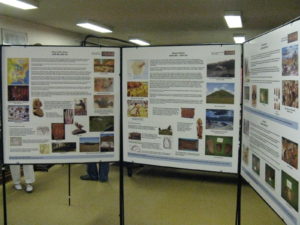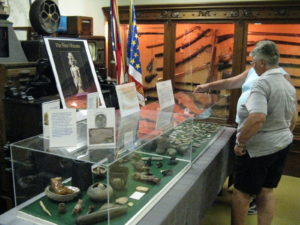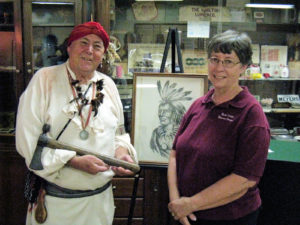The Butler County Historical Society has opened a new exhibition showcasing the museum’s comprehensive collection of Indian artifacts, some of which are 10,000 years old.
The collection of more than 2,500 items is on display in the society’s lower exhibit area at 327 North 2nd Street, Hamilton. The exhibit will run  through the end of the year and is free to the public. It is open Tuesday through Friday from 9 a.m. to 4 p.m. and Saturdays from 9 a.m. to 2 p.m. Free parking is provided at the society.
through the end of the year and is free to the public. It is open Tuesday through Friday from 9 a.m. to 4 p.m. and Saturdays from 9 a.m. to 2 p.m. Free parking is provided at the society.
The exhibit features hundreds of items donated by John F. Burer, Dr. Mark Millikin, and Frank Ramsey and private collections loaned to the historical society by Evelyn and Bill Kuhlman and Ed and Kathy Creighton. Some of the artifacts date from the Paleo-Indian era of 13,000 to 8000 BC. Items from nearly all Indian eras are included in the exhibit.
One of the most interesting pieces is a clay pot of the Fort Ancient culture, dating between 900 to 1650 AD, that was dug up on Campbell’s Island in the Great Miami River by Hamilton physician Dr. H. Lee Good in 1921. A prized artifact is the ax owned by Chief Little Turtle, the Miami Indian chief who had defeated General Arthur St. Clair and was the last signer of the Treaty of Greenville in 1795 making southwest Ohio safe for settlers.
Historical information and details about Indian life covering the Paleo-Indian era; the Adena, Hopewell and Fort Ancient cultures; and the Miami Indian and Shawnee tribes starting in the early 1700s are presented and illustrated in textual boards throughout the exhibit. The Butler County mounds, Indian earth works, Fort Hamilton and Native American wars that affected the Miami Valley are also featured. A small but interesting replica of the interior of a typical wigwam is also presented.
 The exhibit was opened during Dan Cutler’s visit to the historical society to conduct a youth workshop on “Prehistoric People” as part of the Ohio Chautauqua programs held in Hamilton from June 14 to 18. Cutler is a historian and professional enacter of Chief Cornstalk, a Shawnee leader living in Ohio who fought with the French against the British during the French and Indian War of 1754-1763.
The exhibit was opened during Dan Cutler’s visit to the historical society to conduct a youth workshop on “Prehistoric People” as part of the Ohio Chautauqua programs held in Hamilton from June 14 to 18. Cutler is a historian and professional enacter of Chief Cornstalk, a Shawnee leader living in Ohio who fought with the French against the British during the French and Indian War of 1754-1763.
Cutler, as Chief Cornstalk, held the tomahawk/pipe once owned by Miami Indian Chief Little Turtle as Butler County Historical Society Executive Director Kathy Creighton looked on. “I am greatly impressed with the county historical society’s Indian exhibition,” Cutler said. “I think it puts the Indian collection at the Smithsonian Institute to shame.”
The Butler County Historical Society is a private non-profit formed in 1934 to preserve and interpret the county’s rich heritage. It owns and operates the Benninghofen House, a high-Italian style home filled with the furnishings of a wealthy family during the Victorian Era. Group tours of the Beckett exhibit and Benninghofen House Museum can be arranged by calling 513-896-9930.

